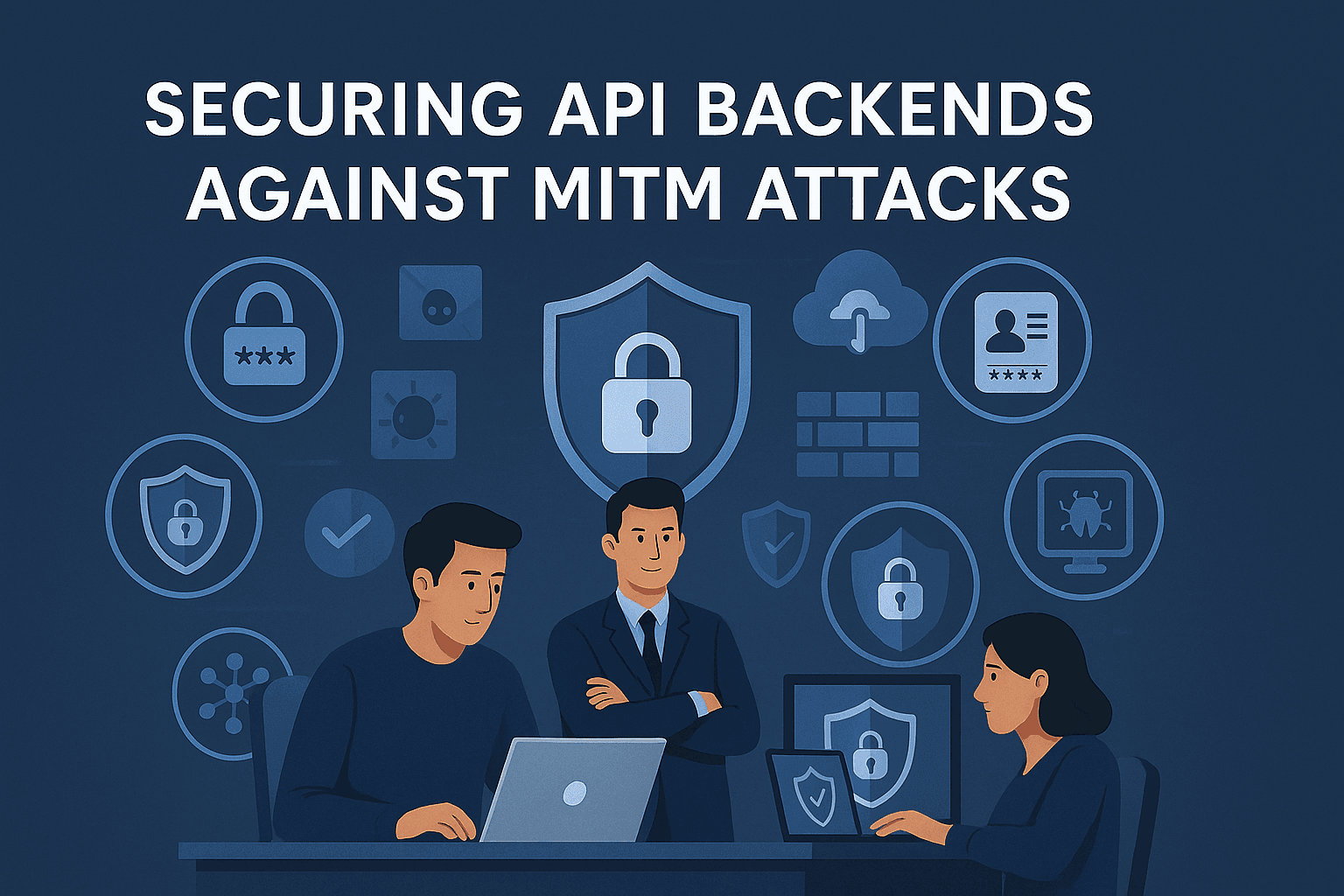
Tenant Data Isolation: Patterns and Anti-Patterns
Explore effective patterns and pitfalls of tenant data isolation in multi-tenant systems to enhance security and compliance.
Jul 30, 2025
Read More
Man-in-the-Middle (MITM) attacks are a growing threat to API security, with API-related breaches costing businesses billions annually. To protect your API backends, you need a multi-layered approach that combines encryption, authentication, and secure network practices. Here’s a quick summary of what you can do:
By implementing these steps, you can reduce the risk of MITM attacks, protect sensitive data, and maintain trust with your users.
Why it matters: APIs are at the core of modern applications, but they’re also prime targets for attackers. With API attacks projected to make up 90% of web-based attacks by 2025, securing your API backends is no longer optional - it’s essential.
Encryption acts as a protective barrier between your API and its clients, ensuring that even if data is intercepted, it remains unreadable. This forms a critical layer of security, supporting additional safeguards like strong authentication and real-time monitoring.
HTTPS is non-negotiable when it comes to securing APIs. Every endpoint should use HTTPS to create an encrypted channel that safeguards data during transmission between clients and servers.
The backbone of HTTPS security is the TLS protocol, and it's crucial to stick to the latest versions. Only allow TLS 1.3 and later, as older protocols like SSLv3, TLS 1.0, and TLS 1.1 are outdated and riddled with vulnerabilities. Attackers often exploit these weaknesses, so make sure your server explicitly blocks connections using these older protocols.
To further enhance security, configure your server to prioritize Perfect Forward Secrecy (PFS) during the TLS handshake. PFS ensures that even if your private key is compromised, past communications remain protected.
Another essential step is enabling HTTP Strict Transport Security (HSTS). This prevents downgrade attacks by forcing browsers to use HTTPS exclusively. Add the following header to all API responses:
Strict-Transport-Security: max-age=31536000; includeSubDomains; preload
This directive ensures HTTPS is enforced for an entire year, covering all subdomains as well.
To avoid service interruptions, use automated tools like Let's Encrypt for certificate renewal. Pair this with monitoring systems to alert you before certificates expire. Automating the renewal process minimizes manual effort and reduces the risk of downtime.
Lastly, consider implementing certificate pinning to add an extra layer of security to your encrypted connections.
While HTTPS provides strong encryption, certificate pinning takes it a step further by verifying the server's identity. With certificate pinning, API clients are configured to trust only specific, pre-approved certificates or public key hashes. During each connection, the client checks the server's certificate against the pinned version and terminates the connection if there's a mismatch.
There are two main methods for certificate pinning:
Careful planning is essential to handle certificate updates, rotations, and load balancing scenarios. Some teams use multiple root certificates to account for browser limitations, as not all browsers fully support certificate pinning.
Before deploying certificate pinning, thoroughly test your implementation under various network conditions and certificate configurations. This helps prevent false positives that could disrupt normal API operations.
Combining well-configured HTTPS with strategically implemented certificate pinning creates a strong shield against man-in-the-middle attacks. These encryption measures not only protect your data but also enhance the effectiveness of other security layers like authentication, monitoring, and access controls.
Strong authentication is key to keeping your APIs safe from unauthorized access. When paired with encryption, it ensures only verified users and systems can interact with your backend services, creating a secure foundation for API operations.
Token-based authentication simplifies API security by replacing the need to send credentials with every request. Instead, users exchange their credentials for a temporary identity token, which is then used for subsequent API interactions. This approach not only secures the credentials but also enhances usability.
A dual-token system is often employed: short-lived access tokens to carry user information and refresh tokens to generate new access tokens as needed. This setup minimizes risk - if an access token is compromised, its limited lifespan reduces potential damage.
JSON Web Tokens (JWTs) are a popular choice for access tokens. They store user-specific details, like roles, in a readable format and are self-contained, allowing APIs to validate them without constantly checking a central database.
To implement token-based authentication securely:
Mutual TLS (mTLS) adds an extra layer of security to standard TLS by requiring both the client and server to authenticate each other before establishing a secure connection. This two-way authentication ensures both parties possess their private keys, making mTLS especially valuable for high-security environments like microservices, IoT, and Zero Trust architectures.
To implement mTLS effectively:
Proper credential storage is essential to API security. To avoid exposing sensitive information:
These strategies create a strong foundation for authentication and credential management, ensuring your APIs remain secure and trustworthy.
Your API gateway acts as the first line of defense against Man-in-the-Middle (MITM) attacks, serving as a centralized checkpoint to control traffic flowing to your backend services. When combined with proper network configuration, this setup strengthens your overall security. Together, these measures work seamlessly with the encryption and authentication strategies discussed earlier.
A well-configured API gateway can significantly reduce vulnerabilities. By centralizing API management, security, and traffic optimization, gateways help ensure consistent protection across all incoming requests. This consistency minimizes the risk of inconsistent security implementations and reduces the attack surface available to MITM attackers.
Key practices for securing your API gateway include:
IP whitelisting adds an extra layer of security beyond tokens and encryption, making it harder for attackers to exploit compromised credentials. Think of it as a strict security guard, only allowing traffic from approved IP addresses.
For instance, in December 2024, the US Department of the Treasury reported that Chinese state-backed hackers stole data from government workstations after compromising an API key from BeyondTrust. While IP whitelisting alone wouldn't have stopped this attack, it could have made the attackers' job more difficult by restricting where the stolen credentials could be used.
To implement IP whitelisting effectively, consider these strategies:
For remote access scenarios, VPN gateways with whitelisted static IPs offer a secure solution. Even for SaaS applications, IP whitelisting is a valuable hardening measure. Pairing IP whitelisting with private networks keeps sensitive communications off the public internet, making it much harder for attackers to intercept data between your clients and servers.
The financial stakes are high. API security breaches now average $6.1 million in damages, a figure projected to nearly double by 2030. To mitigate these risks, use IP whitelisting and private networks as part of a layered security approach. These measures should complement - not replace - the encryption and authentication strategies discussed earlier, creating multiple barriers that make it significantly harder for attackers to compromise your API communications.
Even with strong encryption, authentication, and network security measures in place, continuous monitoring acts as your ultimate safeguard against MITM (Man-in-the-Middle) attacks. Think of it as having a 24/7 security watchtower, ready to spot suspicious activity before it escalates into a major issue.
Real-time monitoring tools are essential here. They keep an eye on network traffic, sending instant alerts if something unusual - like SSL/TLS interception, ARP spoofing, or DNS tampering - pops up. Catching these threats early can stop them in their tracks, adding another layer of security to the encryption and authentication strategies already discussed.
Rate limiting is like a gatekeeper for your system, ensuring no one can overwhelm your resources with excessive requests. For instance, GitHub's API allows up to 5,000 requests per hour per access token. This type of control helps prevent abuse, especially by automated tools exploiting compromised credentials.
Choosing the right rate-limiting algorithm is key. Whether you go with a fixed window, sliding window, or token bucket approach, the goal is to strike a balance: allow legitimate use while blocking suspicious activity. To make this work seamlessly, configure your API gateway or middleware to enforce limits, provide clear error messages (like including a Retry-After header), and consider dynamic rate limits that adapt to real-time server loads.
The December 2024 breach of the Treasury Department highlights the importance of rate limiting. In this case, Chinese state-backed hackers exploited a compromised BeyondTrust API key to reset passwords across government workstations. As Assistant Secretary Aditi Hardikar explained, the attackers accessed a key used to secure a cloud-based service for remote technical support. Rate limiting, however, slowed the attack enough for security teams to detect the unusual activity and respond.
Real-time logging systems are another critical tool in identifying early signs of MITM attacks. SIEM (Security Information and Event Management) solutions analyze network traffic continuously, correlating data from firewalls, servers, and other sources to generate alerts. These systems can flag unusual patterns, such as shifts in IP addresses or geographic locations, which may indicate attacker-controlled traffic. By centralizing logs from various endpoints - firewalls, routers, servers - you create a detailed view of network activity, making it easier to spot coordinated attacks.
Staying ahead of evolving MITM techniques requires proactive security reviews. Regular vulnerability assessments and penetration tests can reveal weaknesses and provide a clearer picture of your API's security. History offers plenty of cautionary tales:
To conduct a thorough security review, start by mapping all API assets and setting clear objectives. Review system configurations, interview key personnel, and gather documentation to fully understand your attack surface. Use both automated scans and manual penetration testing to assess technical, administrative, and physical controls. Document findings with actionable recommendations.
"A security review is a critical component of an organization's cybersecurity strategy. By systematically evaluating security controls, identifying vulnerabilities, and ensuring compliance, organizations can protect their digital assets, prevent security incidents, and build trust with customers and stakeholders."
– SecOps Solution
Scheduling these reviews quarterly - or after major system changes - ensures your defenses stay sharp. As new threats emerge, updating your assessments and adapting your defenses is essential. MITM attacks are constantly evolving, and your monitoring and defense systems need to keep pace with these advanced tactics.
Protecting API backends from MITM attacks is no longer optional - it's a critical business priority. With API attacks surging by over 3,000% year-over-year and 84% of organizations encountering at least one API-related security incident in 2024, the risks are escalating rapidly. Add to that the average cost of a data breach hitting $4.88 million, and it's clear that prevention is far more cost-effective than dealing with the aftermath. A layered defense strategy is essential to address these challenges.
By 2025, API-related security breaches are projected to make up more than 90% of all web-based attacks. The foundation of a secure API ecosystem lies in a multi-layered approach that includes robust encryption, strict authentication, centralized control via API gateways, and continuous monitoring. Each layer plays a specific role: encryption protects data in transit, authentication ensures only legitimate users gain access, gateways enforce policies, and monitoring identifies threats before they cause harm. Alarmingly, business logic attacks now represent 27% of all API attacks, marking a 10% rise from the previous year.
Developers need to act now to implement these security measures and stay ahead of threats:
Shockingly, 30% of API vulnerabilities remain unpatched for more than six months, highlighting the importance of proactive maintenance. Despite 23% of organizations experiencing breaches, only 7.5% have implemented thorough testing and threat modeling programs for their APIs.

Securing APIs requires both technical know-how and strategic foresight. Propelius Technologies brings over a decade of experience in startup leadership and a team of developers who have completed more than 100 projects using modern tech stacks like React.js, Node.js, and cloud platforms.
At Propelius Technologies, we embed security best practices into every project. Our 90-day MVP sprint ensures you can launch secure, production-ready APIs quickly while adhering to the strategies outlined in this guide. We stand by our commitments, offering delay discounts of 10% per week, up to 50%, if we miss agreed timelines. Whether you're looking for a fully developed secure API backend or need to enhance your team with skilled developers, we provide the flexibility to meet your unique security needs.
"Propelius Technologies has been a fantastic tech partner. The team is super responsive, skilled, and professional in their approach. They understood our requirements perfectly and delivered beyond expectations. Their dedication, timely delivery, and support throughout the project truly set them apart. Highly recommended!" - Andreas Sohns, CEO
Our team understands that API security isn't a one-time task - it’s an ongoing commitment. We go beyond building functional APIs by implementing encryption, authentication, monitoring, and testing frameworks designed to combat evolving MITM attack strategies. Whether it’s leveraging AWS cloud solutions or incorporating AI-powered threat detection, we help you create APIs that not only perform but also safeguard your users, business reputation, and partnerships.
Static certificate pinning involves embedding specific certificate details - like hashes or public keys - directly into your app's code. While this method is simple to implement, it comes with a major drawback: any changes to the certificate require releasing a new version of the app. This lack of flexibility can be a headache for developers and users alike.
Dynamic pinning offers a more flexible solution. Instead of hardcoding certificate details, it retrieves and updates the pinned certificates during runtime. This approach allows for seamless adjustments, such as certificate rotations, without the need for app updates. Plus, it adds an extra layer of security, making it tougher for attackers to bypass or reverse-engineer.
For most APIs, dynamic pinning is the smarter choice. It streamlines updates, minimizes maintenance, and provides strong protection against man-in-the-middle (MITM) attacks.
To set up mutual TLS (mTLS) in your microservices architecture and strengthen security, begin by issuing short-lived certificates. These reduce the risk of credential exposure by limiting their validity period. Ensure each service is equipped with properly configured keystores and truststores to enable mutual authentication between them.
Using a hierarchical Certificate Authority (CA) system, with a single root CA and intermediate issuing CAs, can simplify the management of certificates. This structure makes it easier to generate, distribute, and revoke certificates when needed. On top of this, configure your API gateways to enforce mTLS. This ensures that only authenticated services can communicate, effectively blocking man-in-the-middle (MITM) attacks.
By implementing these strategies, you can create a secure communication framework for your microservices, safeguarding sensitive data and ensuring reliable, trusted interactions throughout your system.
To protect your API keys and credentials, start by creating strong, unique keys for every user or service. Make sure not to expose these keys in client-side environments or public repositories. It's also a good idea to rotate keys regularly and apply granular permissions, granting access only to what’s absolutely necessary.
When it comes to storing API keys, keep them secure by encrypting them when at rest and using reliable storage methods like environment variables or secret management tools. Strengthen security further by enforcing strict access controls, keeping an eye on usage to detect any unusual activity, and immediately revoking keys if they’ve been compromised.
By sticking to these practices, you’ll greatly lower the chances of unauthorized access and keep your API credentials safe.
Need an expert team to provide digital solutions for your business?
Book A Free CallDive into a wealth of knowledge with our unique articles and resources. Stay informed about the latest trends and best practices in the tech industry.
View All articlesGet in Touch
Let's Make It Happen
Get Your Free Quote Today!

Get in Touch
Let's Make It Happen
Get Your Free Quote Today!

